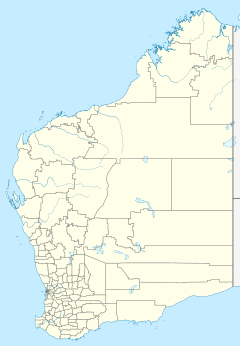Charnley River–Artesian Range Wildlife Sanctuary facts for kids
Quick facts for kids Charnley River–Artesian Range Wildlife Sanctuary |
|
|---|---|
|
IUCN Category VI (Managed Resource Protected Area)
|
|
| Area | 300,060 ha (1,158.5 sq mi) |
| Designation | private nature reserve |
| Operator | Australian Wildlife Conservancy |
The Charnley River–Artesian Range Wildlife Sanctuary is a very large protected area in the Kimberley Region of Western Australia. It covers about 3,000 square kilometres (1,158 square miles). This sanctuary is located about 205 kilometres (127 miles) east of Derby. You can reach it by using the Gibb River Road. The sanctuary gets its name from the Charnley River that flows through it.
This special place is looked after by the Australian Wildlife Conservancy (AWC), which is a charity. The sanctuary used to be a cattle farm called Charnley River Station. Before that, it was known as Beverley Springs Station. The AWC also works with the Department of Biodiversity, Conservation and Attractions. They even lease some land to another company, which still runs a cattle farm there. But important areas like rivers are kept safe from the cattle. The AWC has a wilderness camp and a visitor centre. People can go hiking and swimming in the beautiful gorges here.
History of the Station
The land that is now the sanctuary has an interesting past. It was once a large cattle farm called Beverley Springs Station. In 1969, the Nixon family bought the property. It was quite run-down back then. This station was the first place along the Gibb River Road to offer places for tourists to stay. Marion Nixon, who lived there, wrote books about raising her five children on the station.
Later, in 1981, the Barrett family took over the property. Two sons, Matt and Russell, made an exciting discovery. They found a new type of pitcher plant on the land! They later became botanists, studying plants in the Kimberley region. They even rediscovered a plant species that was thought to be extinct. It had only been seen once before, way back in 1821.
In 2010, Peter and Cheryl Camp bought the property. They changed its name to Charnley River Station. They had about 3,000 cattle and also worked to make it a better place for tourists. But in February 2011, they sold the property to the Australian Wildlife Conservancy, turning it into the wildlife sanctuary we know today.
What the Sanctuary is Like
The Charnley River–Artesian Range Wildlife Sanctuary is a huge area, about 3,000 square kilometres (1,158 square miles). The AWC manages this land to protect its wildlife. Part of the land is still used for cattle farming. The AWC leases about 300,000 hectares (741,316 acres) to a company that raises Brahman cattle. However, these cattle are not allowed in important natural areas, especially near rivers.
The AWC works hard to control feral animals and weeds across the sanctuary. Feral animals are those that are not native and can harm the environment. They include pigs, donkeys, cattle, and brumbies (wild horses). The AWC also studies how to control fires, especially in the lower savannah areas. They want to see how these threats affect different wildlife species.
If you want to visit, you can access the old Charnley River Station from the Gibb River Road. It's about 43 kilometres (27 miles) from the turnoff. The station offers places for campers, but it no longer provides accommodation or meals. There are three amazing gorges with fresh water pools: Paradise Pool, Dillie Gorge, and Donkey Hole. Two of these pools are fed by natural springs. The property even has its own airstrip.
Amazing Wildlife
The Charnley River–Artesian Range Wildlife Sanctuary is home to many special animals. It has 11 threatened species, which means they are at risk of disappearing. There are also 29 other species that are either endemic (found only in this area) or have very small populations in the Kimberley.
Some of the cool Mammals you might find here include:
- The Wyulda, also known as the scaly-tailed possum.
- The tiny rock-wallaby called monjon.
- The Kimberley rock rat.
The sanctuary also has unique birds, such as the black grasswren and the Kimberley honeyeater. There are many special reptile species too, like the rough-scaled python, the Kimberley crevice skink, and several types of geckos. Some animals that are now extinct in many other places can still be found here. These include the golden-backed tree-rat and the golden bandicoot.
Nearby Areas
The Charnley River–Artesian Range Wildlife Sanctuary shares its borders with other important areas. To the south-west, it is next to the Wunaamin Miliwundi Ranges Conservation Park. This park used to be known as Mount Hart Station. To the south-east, you'll find Mount House Station.
To the north and east, Charnley River is next to the Wilinggin Indigenous Protected Area. This area is managed by Indigenous Australians to protect their land and culture. There was also a historic Aboriginal cattle station called Munja, or Avon Valley Cattle Station, in this general area.


